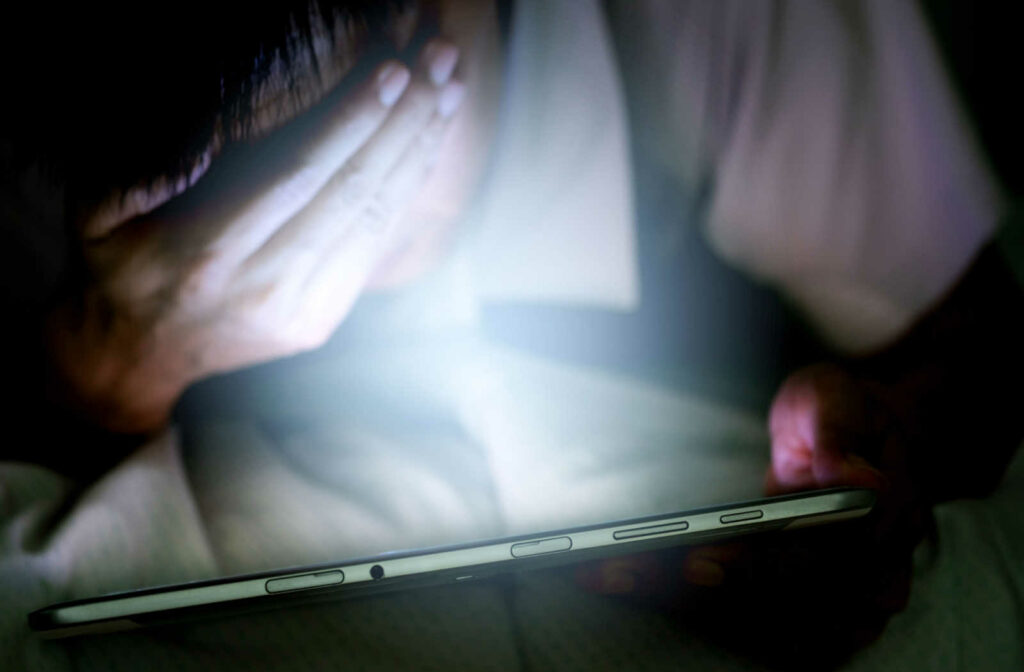Reducing Eye Strain
Eye strain is an uncomfortable, often distracting symptom. It has various causes, from sleep deprivation to vision problems. Although it can be a short-term symptom, eye strain can last much longer. Therefore, you should contact your eye doctor whenever you experience changes to your vision or eye discomfort.
In most cases, eye strain is temporary and tends to resolve within a few hours or days once the triggering activities, such as prolonged screen use or reading in poor lighting, are reduced or eliminated.
To help reduce eye strain, you can practice the following measures in your day-to-day life:
- Taking breaks from screen time or close up work
- Practicing proper eye care habits
- Ensuring an ergonomic environment when viewing a digital device
However, if the symptoms persist or worsen, it’s important to consult with your eye doctor for a thorough evaluation and appropriate guidance. Seeking ocular health services can make a difference in how long your eye strain lasts.
Symptoms of Eye Strain
Feeling like your eyes are fatigued is the most common indicator of eye strain. However, it’s possible to experience eye strain without feeling like your eyes are “strained,” as you may interpret your symptoms differently. Alternatively, you may only experience a few symptoms.
Some typical symptoms of eye strain can include:
- Blurry or double vision
- Burning or itchy eyes
- Dry eyes
- Eye pain or headache
- Eye twitching
- Frequent squinting
- Light sensitivity
- Poor concentration
What Causes Eye Strain?
Although eye strain includes various symptoms, eye strain can also be a symptom. There are many eye problems or health factors that can cause eye strain. Knowing the cause can help you implement appropriate treatment. It can also help determine how long your eye strain might last.
Common causes of eye strain are:
- Digital eye strain
- High-stress levels
- Lack of sleep
- Prolonged visual activity
- Poor lighting or blue light
- Poor posture
- Vision problems
How Vision Problems Cause Eye Strain
While eye strain can temporarily accompany a headache or lack of sleep, your eye strain may be a long-term symptom related to an untreated vision problem. When you see an optometrist for an eye exam, they may prescribe prescription lenses—glasses or contacts—to help correct a refractive error.
Examples of refractive errors include:
- Astigmatism
- Hyperopia (farsightedness)
- Myopia (nearsightedness)
- Presbyopia
Refractive errors occur because eye shape prevents light from focusing correctly on the retina (tissue located at the back of the eye). As a result, you might have trouble focusing or squint to compensate for blurry vision. Because your eyes focus more intensely to create a clearer image, you can experience eye strain.
Prescription lenses help bend light to focus more accurately inside the eye. However, your glasses or contact lenses don’t cure or alter the refractive error. Instead, the lenses work with your natural eye structures to help light reach the retina. Therefore, when you remove your glasses or contact lenses, symptoms can reoccur.
Prescription lenses are essential for relieving symptoms, protecting eye health, and enhancing vision.

Digital Eye Strain Management
Digital eye strain, also called computer vision syndrome (CVS), occurs due to excess screen time. Viewing a digital screen for a prolonged period can exhaust your visual system, as your eyes work harder to focus. Additionally, untreated vision problems, including refractive errors, can contribute to digital eye strain symptoms.
CVS or digital eyes strain symptoms include:
- Eye strain
- Dry eyes
- Headaches
- Blurry vision
- Neck or shoulder pain
Although the time you spend viewing your device can cause symptoms, it’s also crucial to be careful of how you view it. For example, common causes of CVS include:
- Inadequate viewing distance
- Poor lighting conditions
- Poor posture
- Screen glare
The 20-20-20 rule can help prevent and relieve the symptoms of digital eye strain. For every 20 minutes of screen time, take a break for at least 20 seconds to focus on a distance of 20 feet away. It takes a minimum of 20 seconds for your eyes to relax, but you can also schedule a longer break according to your comfort.
Other solutions include:
- Adjusting your viewing space
- Adding a blue light filter
- Using eye drops (for dry eyes)
Combining the 20-20-20 rule with additional solutions can help reduce the risk of developing eye strain and help you recover faster when it becomes a problem.
How Long Can Eye Strain Last?
How long your eyes strain lasts can depend on various factors, from the cause to your unique eye health. Taking screen breaks, wearing your prescription lenses, and getting some rest are generally helpful tips. However, consulting your eye doctor can provide more specific advice personalized for your symptoms, lifestyle, and eye care needs.
Can Eye Strain Last for Days, Weeks, or Months?
For minor symptoms, you may find a screen break or wearing accurate prescription lenses offers relief within a few minutes or hours. However, it may take a few days to recover if you’re experiencing eye strain because of a sleep deficit.
When an eye problem or health condition is the cause of your symptoms, you may require an updated prescription or new medication. As a result, it can take longer, including a few weeks, before you feel relief from eye strain.
Diagnosing the cause is the first step to learning how to relieve your eye strain. The sooner you can understand the cause of your eye strain and implement treatment, the sooner you can reduce your symptoms.
Eye Strain Treatment
When you’re experiencing eye strain, talk to your optometrist as soon as possible. They can examine your eyes and discuss your symptoms to determine the appropriate treatment or recommend eye care solutions.We want to help you achieve comfortable vision. Schedule an appointment at Charles Korth Optometry today!




